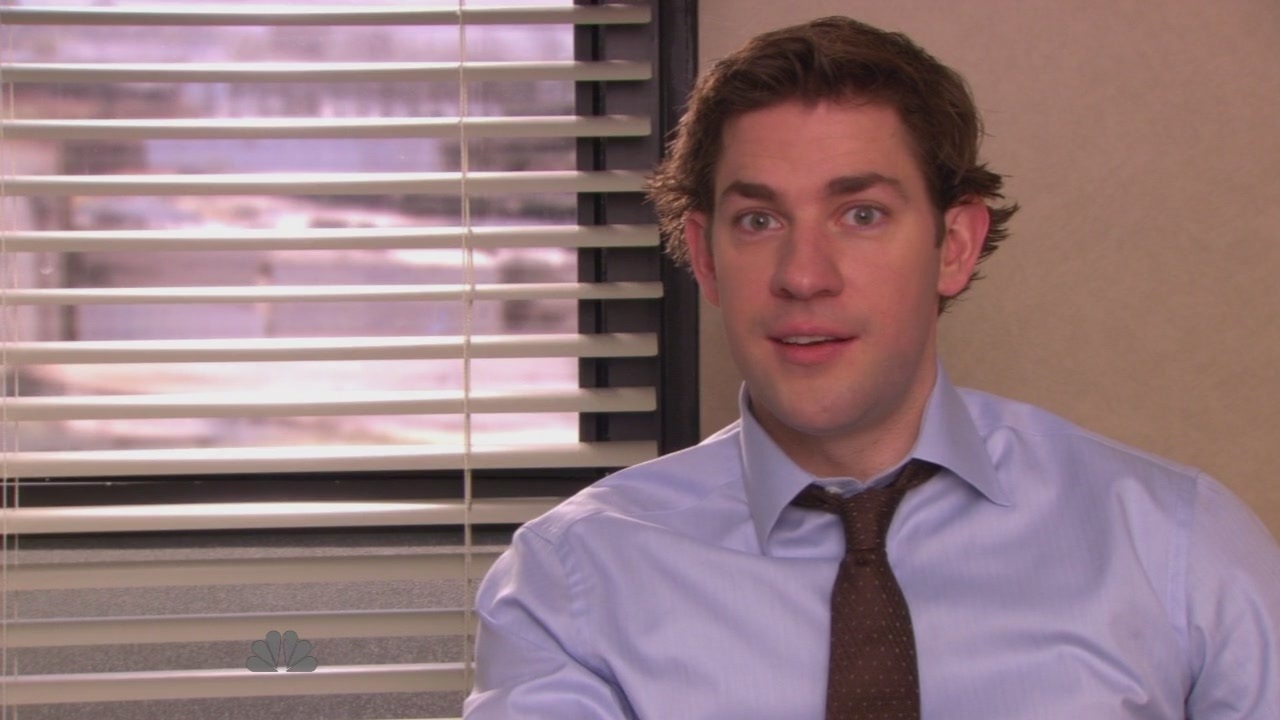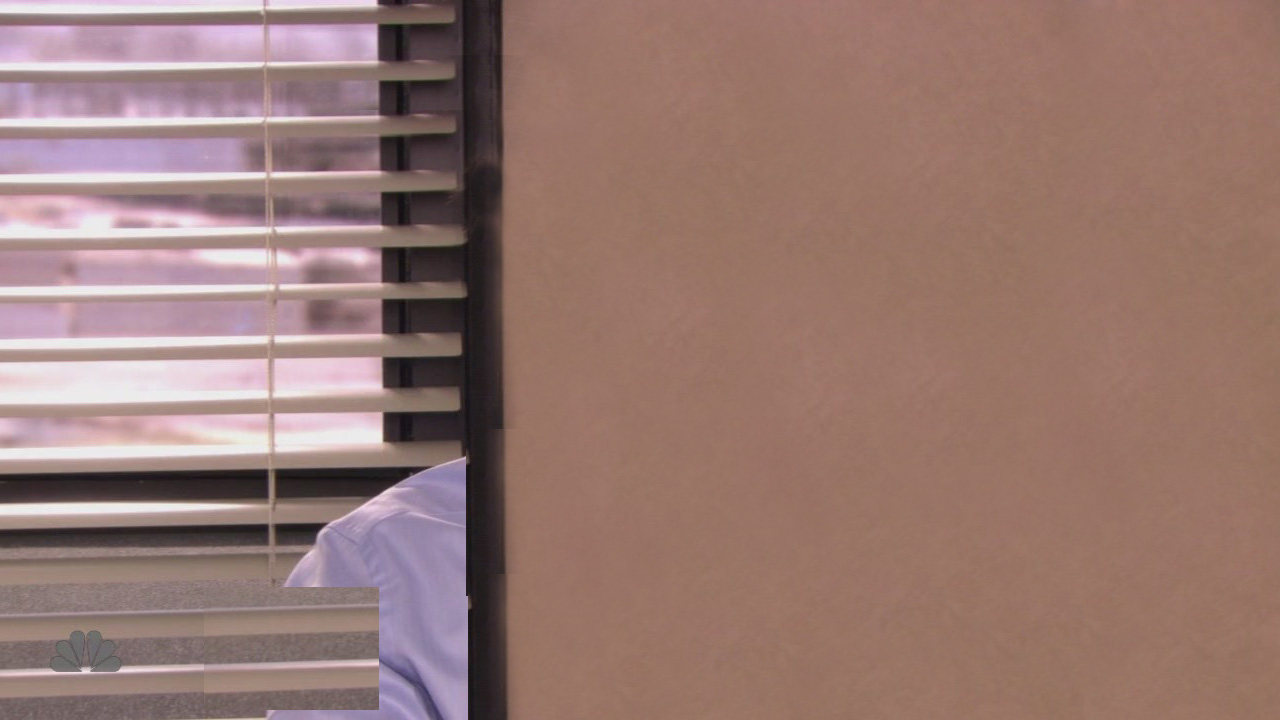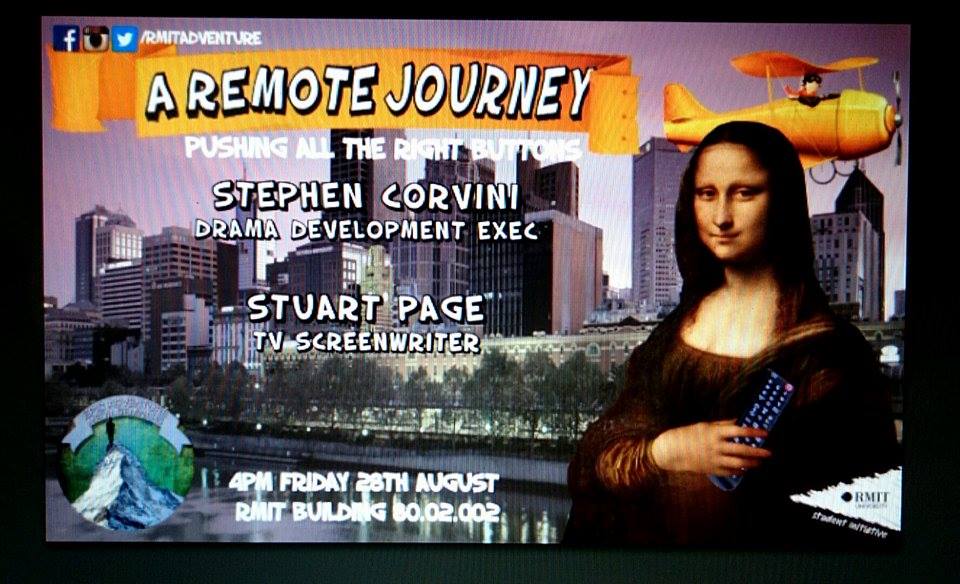Having been fortunate enough to travel with my family growing up, I have been exposed to a lot of different cultures. I’ve holidayed in Tokyo, Orlando, Auckland and Montreal to name a few, but you know what they say, there’s no place like home.
And it’s true! Melbourne has once again been dubbed the most liveable city in the world for the fifth year in a row. The ranking is constructed over a number of factors, including the city’s infrastructure, it’s availability of goods and services and level of personal risk. Despite the beautiful places in our world that I have seen, I still have so much more to explore, but I can’t imagine I will ever find a place as interesting and upbeat as Melbourne.
But what makes Melbourne… well, Melbourne?
It’s our people. Melbourne is an amazingly diverse city. We have no one style, religion, language, appearance; we are different and we are unique. We all have different stories and different backgrounds, but there’s a true Melbournian quality that shines through; each Melbournian, no matter how different to the last, radiates this quality through and through. Melbournians have a wonderful approach to life in which we set our souls free- we dare to take risks and care not what people think. We have no time for prejudice or disrespect. We embrace difference, we embrace individuality, and we embrace confidence.
Thus, Melbourne city seemed like the perfect place for some intense people-watching. As a general instinct, we often find ourselves watching others. We take note of people’s style, their body language, their gait and their overall vibe, creating a projection in our heads of what a person is like, or how we can predict their responses to certain situations.

As I sat outside State Library embracing the rare August sun, I watched in silence as the world carried on around me. The green lawn I walk past each day on my way to class was for once, not as empty as I had usually seen in the previous winter months. Various groups of people had taken their place on the grass; mothers with their young children, dog owners, office workers and tradies on their lunch breaks, and many tertiary students taking a time out from their assignment ridden schedules, even some bringing laptops or books with them in an attempt to ease the guilt of skipping class.

As I found myself a spot on a bench at the tram stop, I noticed in particular, a grandmother playing with her two young grandchildren, one girl and one boy. While most individuals and groups of friends kept to themselves on the lawn and stayed in one spot, these children ran wild, chasing the terrifyingly brave seagulls away from other peoples’ meals in a superhero fashion. This continued on for quite some time, and people generally seemed interested in the boy and his bubbly energy. Not long after, the young boy noticed a dog. Excitement shot out of the boy like the end-of-day fireworks at Disneyland as he sprinted over to a girl in a flannelette shirt and a yellow beanie, putting his hands together as if to pray and politely asking if he could “pretty, pretty, pretty, pleeeeassse” pat her dog. Even before she had said yes, he had both arms around her dog before pausing quickly as he remembered to say “thank you”, smile wide than ever. The young boy played with the dog for so long that his grandmother had to eventually drag him away.
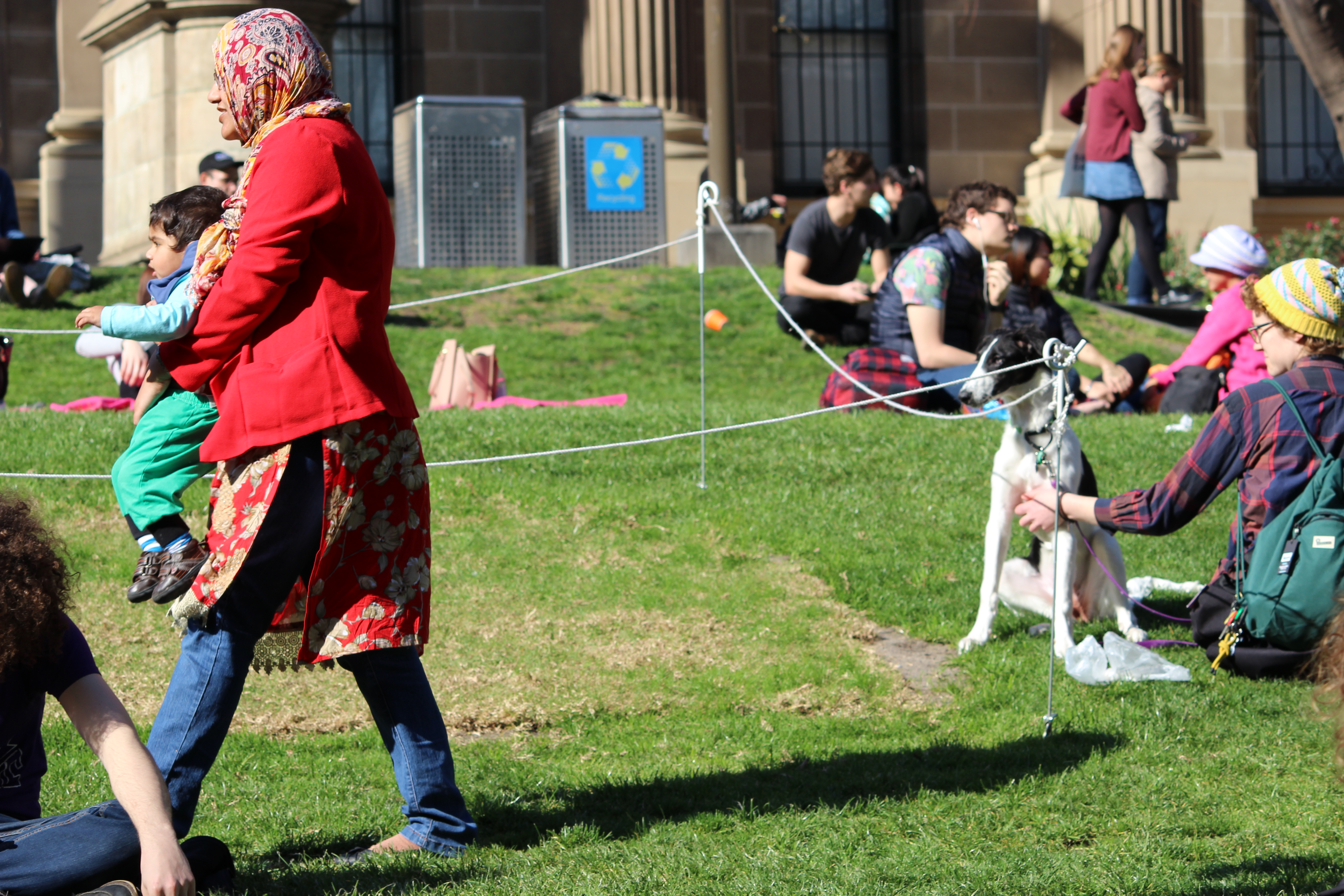 What interested me the most about this situation was that I noticed that children were a lot more proactive in asking for what they wanted- they do the things that we as adults feel like we cannot “get away with”, or things that we generally avoid in public. For example, children often throw tantrums in shopping centres when they cannot get what they want. Their explosion of emotion is something that we as adults feel we cannot do in a similarly emotive situation, even if we feel the urge to. As we develop from child to adult, we learn about social norms and rituals, which tell us that we can’t ask a stranger to share their lollies with us, or feel totally shameless about crying in public. As we grow older we care more what people think of us, and place pride and dignity above our truest desires. Where adults act how they think society wants them to act, children act however they want to and how they feel, not worried what others think of their behaviour.
What interested me the most about this situation was that I noticed that children were a lot more proactive in asking for what they wanted- they do the things that we as adults feel like we cannot “get away with”, or things that we generally avoid in public. For example, children often throw tantrums in shopping centres when they cannot get what they want. Their explosion of emotion is something that we as adults feel we cannot do in a similarly emotive situation, even if we feel the urge to. As we develop from child to adult, we learn about social norms and rituals, which tell us that we can’t ask a stranger to share their lollies with us, or feel totally shameless about crying in public. As we grow older we care more what people think of us, and place pride and dignity above our truest desires. Where adults act how they think society wants them to act, children act however they want to and how they feel, not worried what others think of their behaviour.
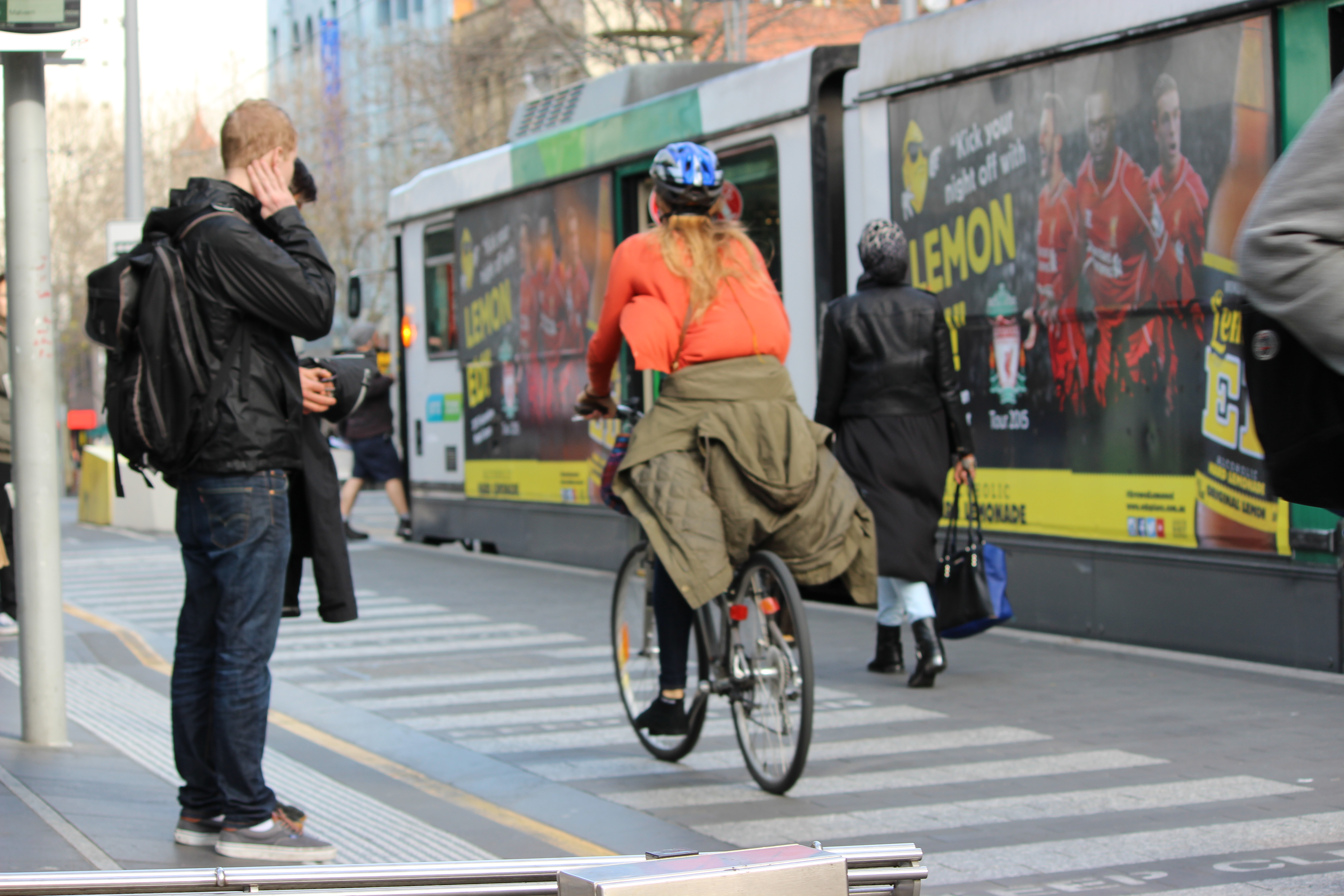
After I considered my first observation, I was distracted by the loud clacking of the tram tracks as a tram approached on Swanston Street behind me. I turned around as people poured out of the tram on to the bike lane. As people slowly oriented themselves and tried to navigate their way on Swanston Street, a lady in an orange jacket was fast approaching on a bike. She was going at a relatively fast speed and made no effort to slow down. She rang her bell several times, smiling at pedestrians while politely waving them aside. Fellow pedestrians helped each other off the bike lane and on to the sidewalk, and in seconds, the cyclist had a clear path alongside the tram. Debunking the stereotype that cyclists are selfish, egotistical road-hoggers, the lady yelled a quick thanks to those now behind her as she rode swiftly down Swanston Street on her now clear path. A common occurrence, which happens frequently in the City struck me as an incredible feat of trust between stranger to stranger. The cyclist had full trust in the idea that if she rang her bell, people would move out of her way, and despite her speed, no pedestrians seemed frantic or startled or scared as the cyclist sped past them- they heard the bell, and calmly moved out of the way, trusting that the cyclist would manoeuvre around them accordingly.

While strangers could trust that other strangers would not physically hurt them, it appeared that strangers could not do the same on a mental level. As I turned back to the lawn, I had realised that I wasn’t the only one people-watching that day. As I raised my lens to take a photo, I noticed some people turning their heads away, wanting to hide their faces and trying to shift their bodies out of frame. Seemingly, it wasn’t so much my presence that affected people, but the idea that I was taking photos of them which would somewhat cement their place in that moment forever, and that they were unaware what would happen to that information. I began to watch the public go by for a while without my camera, and noticed people making eye contact with me, assessing me and observing me in return. As I tried to act cool and avoid their gaze, being sure to alter my body language in order to present myself as a friendly person and in doing so, realised that I was acting in the same self-conscious manner that my subjects were behaving towards me. The major link I made between all three of my observations was that they all related to social norms and how we act in accordance to social norms is a reflection of us as a part of society and our contribution to the strength of said norms.

As adults in a modern day society, we conform to a set of social norms- a set of behavioural rules, which are deemed “appropriate” in a group or society. We use our manners, are wary of others and think before we act. And in a big, bustling city like Melbourne, the city is full of completely different individuals who, for the most part, adhere to these social norms, almost as an unspoken rule. But of course, not all of us feel the need to adhere to these rules- while some adults were able to confidently step away from the majority (such as the man who took his shirt off so he could relax on the grass without getting a t-shirt tan), it was mostly children who were so confident in themselves and their desires that they weren’t afraid to act exactly how they wanted and express how they felt; a trait that I wish adulthood hadn’t made me feel obligated to mask. But even so, these social norms are what help us to function smoothly as a society. We walk only when the green-man says we can, we alert ourselves when we hear a siren or a bell, and we smile at other runners during our morning jog. We make these associations not as a coward’s approach to avoiding conflict, but as a mutual understanding and mutual respect for one another. We as adults, and we as humans, have the capability to recognise that while we are all unique individuals, there’s a truth in the idea that we are all cut from the same cloth and we are all equal and deserving. I strongly feel that this idea is a true reflection of the Melbourne way of life, not because it is an understanding which is unique to Melbourne, but because it is the reason I am proud to call Melbourne my home.
http://www.mediafactory.org.au/regina-lee/?p=388


 What interested me the most about this situation was that I noticed that children were a lot more proactive in asking for what they wanted- they do the things that we as adults feel like we cannot “get away with”, or things that we generally avoid in public. For example, children often throw tantrums in shopping centres when they cannot get what they want. Their explosion of emotion is something that we as adults feel we cannot do in a similarly emotive situation, even if we feel the urge to. As we develop from child to adult, we learn about social norms and rituals, which tell us that we can’t ask a stranger to share their lollies with us, or feel totally shameless about crying in public. As we grow older we care more what people think of us, and place pride and dignity above our truest desires. Where adults act how they think society wants them to act, children act however they want to and how they feel, not worried what others think of their behaviour.
What interested me the most about this situation was that I noticed that children were a lot more proactive in asking for what they wanted- they do the things that we as adults feel like we cannot “get away with”, or things that we generally avoid in public. For example, children often throw tantrums in shopping centres when they cannot get what they want. Their explosion of emotion is something that we as adults feel we cannot do in a similarly emotive situation, even if we feel the urge to. As we develop from child to adult, we learn about social norms and rituals, which tell us that we can’t ask a stranger to share their lollies with us, or feel totally shameless about crying in public. As we grow older we care more what people think of us, and place pride and dignity above our truest desires. Where adults act how they think society wants them to act, children act however they want to and how they feel, not worried what others think of their behaviour.



